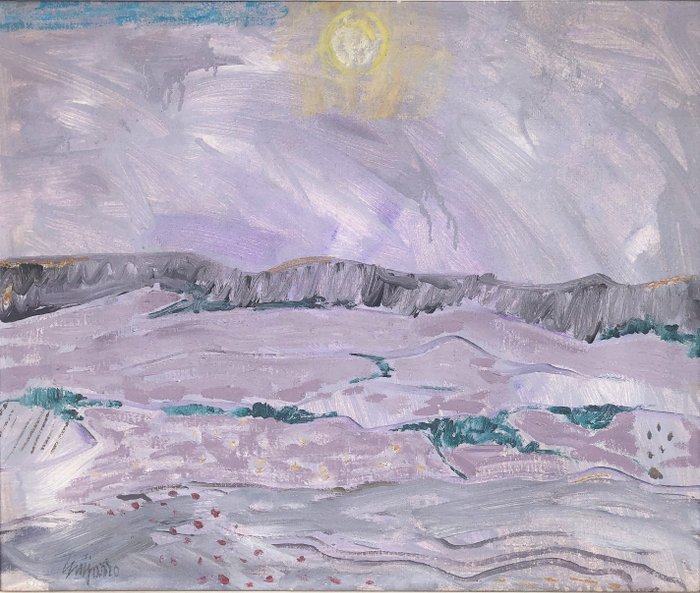
Enric Beltran Messa (1940-2006) - Paisaje lacustre
编号 41950237

编号 41950237

Antonio Guijarro Gutiérrez (Villarrubia de los Ojos, Ciudad Real, 17th February, 1923 – 25th May, 2011, Madrid) was a Spanish non-realist figurative painter and sculptor.
Antonio Guijarro Gutiérrez or ‘Guijarro’ as he was known in the art world, was a Spanish figurative painter inscribed in the so-called Escuela Madrileña although Guijarro says of himself that he does not belong to any movement, his style is the “Guijarrismo”.1 He obtained the first prize at the Concurso Nacional de Pintura 2 in 1954 for his work Virgen Sentada
Childhood
1932.- He painted El Moro Músico (1932) when he was not even 10 years old during his stay in Tétouan (Morocco), a place where his father had been sent for professional reasons. In 1951 this work was awarded with an Accésit at the Second Exhibition of Painters from Africa 3.
Youth
1934.- He took the entrance exam to follow secondary education studies at the Instituto de San Isidro, in Madrid.
1937.- As a consequence of the Spanish Civil War he came back to Ciudad Real with his family, where he enrolled at the School of Arts and Crafts of Castilla La Mancha’s capital. He stayed there for two years.
1939.- The war came to and end and he went back to Madrid with his family.
1940.- He moved to Alcoy (Alicante) with his family.
1942.- He entered at the Escuela Elemental de Trabajo of Alcoy, where he studied Mechanical Expertise. In that institution he worked as an artistic drawing teacher at the evening classes for adults. There he met the sculptor Tomás Ferrándiz Llopis (Alcoy, 1914 - Madrid, 2010) who recommended him to follow higher education in the arts. Encouraged by his father he travelled to Valencia and he successfully completed the entrance exam at the Escuela de Bellas Artes de San Carlos, where he was granted free tuition.
During the post-war period, Guijarro worked as a decorator in the Fallas workshops in order to get some income.
1943.- After a fight with the delegate of the Phalangist trade union organization SEU (Sindicato Español Universitario) he received a letter urging him to leave the Escuela de Valencia without the possibility of taking the end-of-year exam.
1945.- He returned with his family to Madrid, where he continued his studies at the Escuela de Bellas Artes de San Fernando.
1948.- He finished his studies at the Escuela de Bellas Artes de San Fernando and he studied sculpture under the tutelage of the Professor of Natural Modelling and Sculptural Composition Enrique Pérez Comendador.
1949.- He carried out his military service as Ensign of Complement. He exhibited his work for the first time at the Instituto de Estudios Manchegos of Ciudad Real.
Maturity
1951.- His first solo exhibition took place at the Biosca Gallery in Madrid (located at 11 Génova Street). That same year he participated in the Eighth Salón de los Once de la Academia Breve de Crítica de Arte, an exhibition where the eleven best works of all exhibitions held in Madrid during the year were made known.
The Academia Breve de Crítica de Arte was promoted by the philosopher Eugenio dˈOrs. There, Guijarro exhibited his works with the painters Emilio Varela, Rafael Zabaleta, Darío Suro, Manuel Baeza, Francisco Capuleto, Tony Stubbin, Cirilo Martínez Novillo, Santiago Uranga, José Caballero and Julio Ramis.
1952.- He was selected again for the Salón de los once. That same year he took part at the 25th Venice Biennale. His work Campesina de Carabanchel (1952) was acquired by the Venice Gallery of Modern Art (Italy).
1953.- He married the painter and cartoonist Isabel Agero. He obtained the Conde de Cartagena scholarship and he obtains a grant in New York from the Real Academia de Bellas Artes de San Fernando. His first daughter, Mabel, was born in that city. In his own words, the American experience held him learn what not to do in art. 4
1954.- He travelled to Equatorial Guinea with a grant from the Instituto de Estudios Africanos.
1955.- He received a grant from the Fundación Rodríguez Acosta en Roma. His second child, Antonio, was born.
1964.- He travelled with his family to Norway and he exhibited his works in Oslo, Vinstra and Tonsberg.
1966.- He obtained the Chair of Colour at the Escuela de Bellas Artes de San Fernando of Madrid in a public examination and with the majority of votes. He retired early, in 1988.
1973.- He obtained a scholarship from the Pacific Area Travel Association (PATA) thanks to which he travelled along the west coast of the United States. Japan, Taiwan and Korea. The program selected artists who were representative of the world in order to perform a traveling exhibition.
1984.- He painted the King Juan Carlos I and Prince Felipe of Asturias for the Club Siglo XXI, in Madrid5. In this work stand out the casual attitude of the protagonists and the stroke of the flag.
Distinctions:
1952.- Third medal at the Nacional de Bellas Artes of Madrid. Niños del caballo blanco.
1953.- Golden medal at the XV Exposición Nacional de Valdepeñas.
1954.- First Prize at the Concurso Nacional de Pintura. Honorary Medal at the Exposición de Pintores de África. Second Medal at the Exposición Nacional de Bellas Artes.
1955.- Golden Medal Riviera della Versilia at the Internacional de Viareggio (Italia).
1957.- First Medal at the Nacional de Bellas Artes of Barcelona. Bodegón con peras.
1963.- II Bienal de Pintura of Zaragoza. Interior.
1968.- Bronze Medal at the V Bienal de Alejandría.
1970.- Pámpana de Oro at the Exposición Nacional de Artes Plásticas de Valdepeñas.